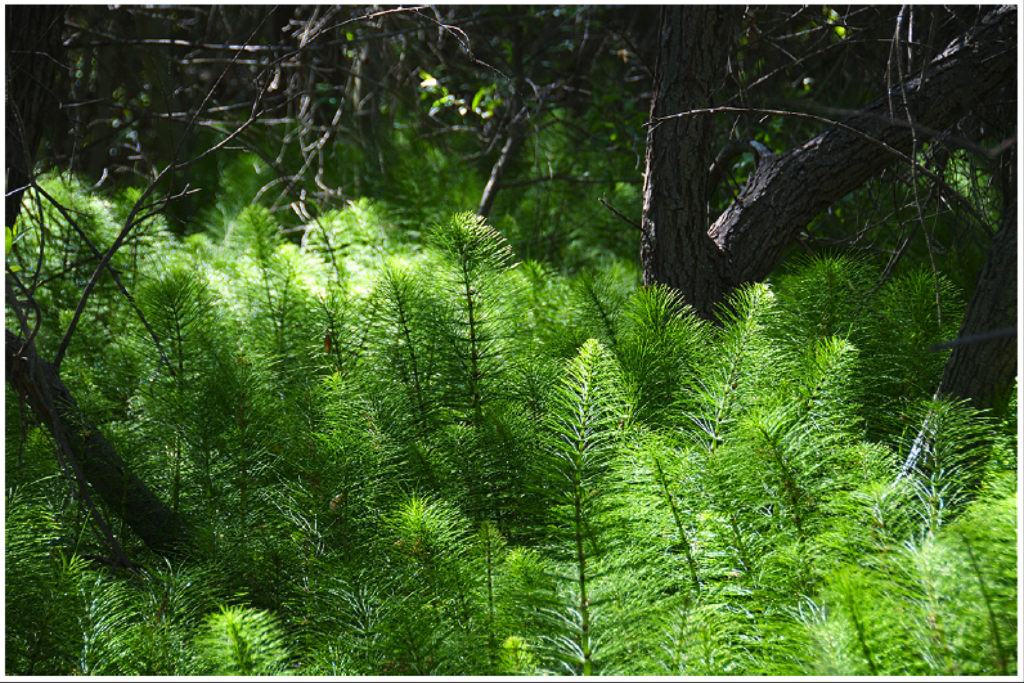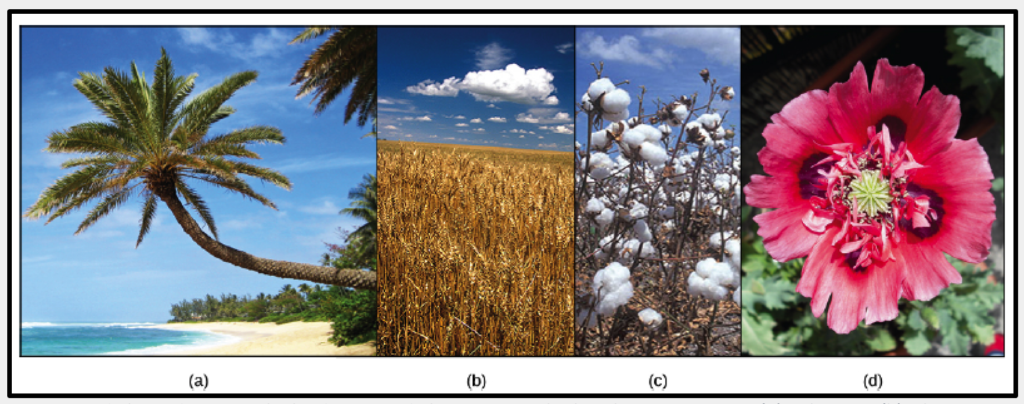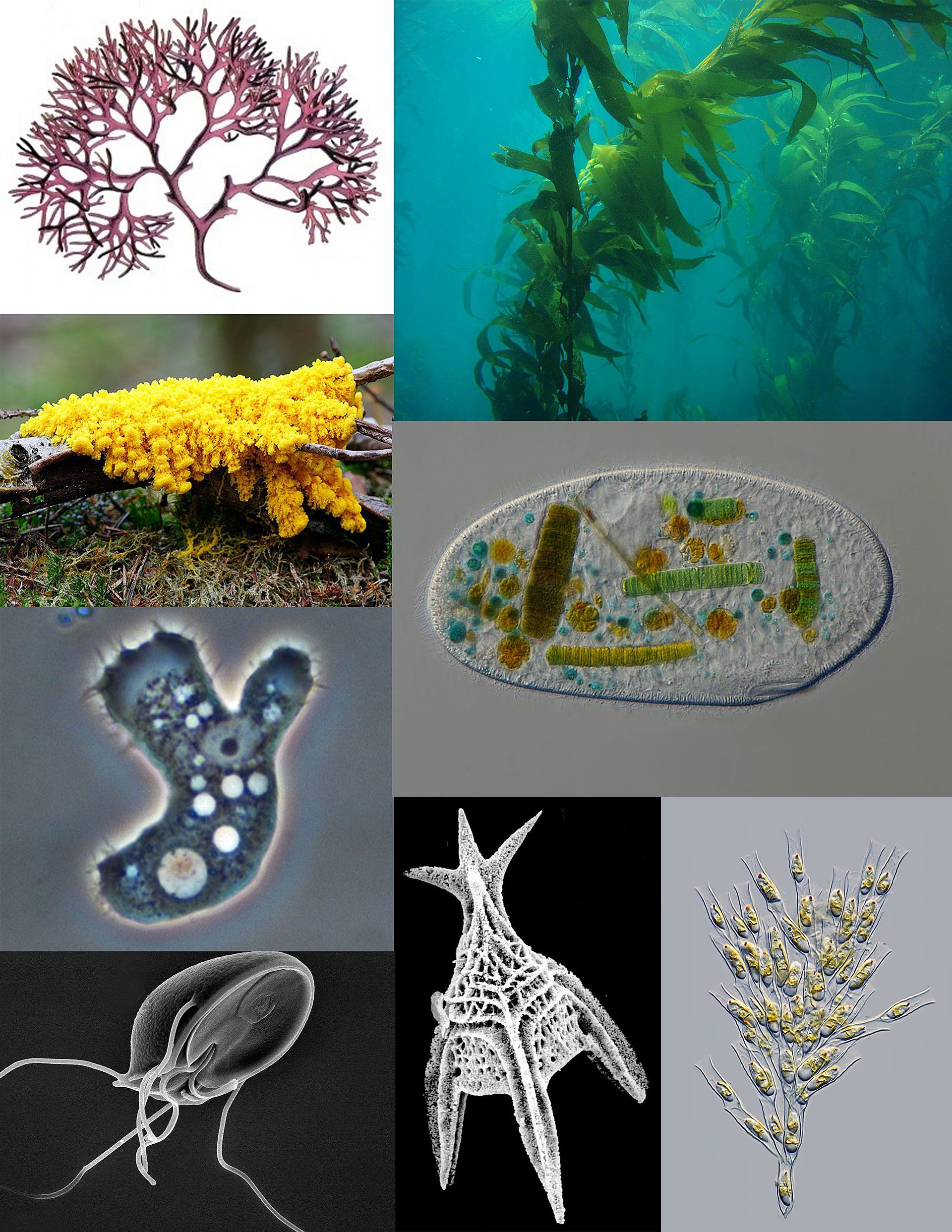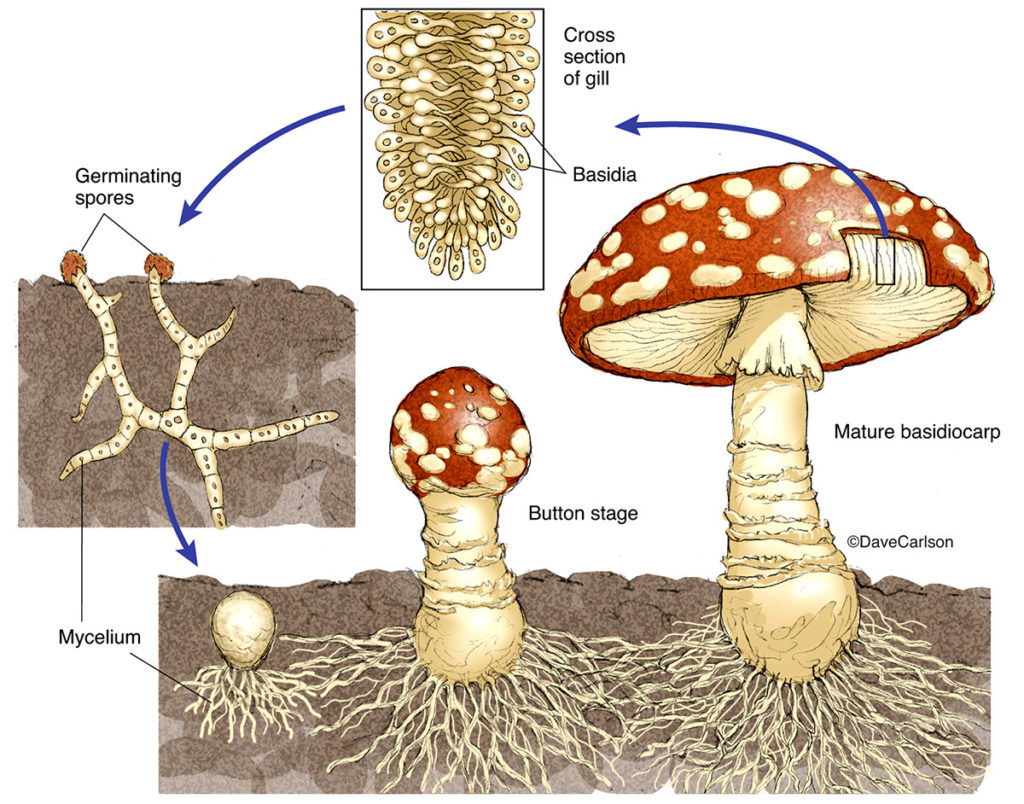Plants
The kingdom Plantae constitutes large and varied groups of organisms. There are more than 300,000 species of catalogued plants. Mosses, ferns, conifers, and flowering plants are all members of the plant kingdom. Current evolutionary thought holds that all plants are monophyletic; that is, they are descendants of a single common ancestor. The evolutionary transition from water to land imposed severe constraints on plants. They had to develop strategies to avoid drying out, to disperse reproductive cells in air, for structural support, and for capturing and filtering sunlight.
Plants that lack tissues for the transport of water and nutrients, are referred to as non-vascular plants. Liverworts, mosses, and hornworts (collectively known as bryophytes) are seedless, non-vascular plants that likely appeared early in land plant evolution. Early land plants, like the early land animals, did not live very far from an abundant source of water and developed survival strategies to combat dryness. One of these strategies is called tolerance. Many mosses, for example, can dry out to a brown and brittle mat, but as soon as rain or a flood makes water available, mosses will absorb it and are restored to their healthy green appearance. Another strategy is to colonize environments with high humidity, where droughts are uncommon.

Vascular plants developed tissues to conduct water and solutes. Xylem is the tissue responsible for the storage and long-distance transport of water and nutrients. It also has rigid cell walls that provides support to the plant and allows it to achieve impressive heights. Tall plants have a selective advantage by being able to reach unfiltered sunlight and disperse their spores or seeds further away, thus expanding their range. Phloem is the second type of vascular tissue; it transports sugars, proteins, and other solutes throughout the plant. Water is still required for fertilization of seedless vascular plants, and most favor a moist environment. Modern-day seedless vascular plants include club mosses, horsetails, ferns, and whisk ferns. Ferns, which are considered an early lineage of plants, thrive in damp and cool places such as the understory of temperate forests.
The seed plants form the largest group of all existing plants, anddominate the landscape. Seed plants include gymnosperms, most notably conifers (Gymnosperms), which produce “naked seeds,” and the most successful of all plants, the flowering plants (Angiosperms).
Seeds and pollen—two critical adaptations to drought, and to reproduction that doesn’t require water—distinguish seed plants from other (seedless) vascular plants. Both adaptations were required for the colonization of land begun by the bryophytes and their ancestors. Fossils place the earliest distinct seed plants at about 350 million years ago.
Gymnosperms, meaning “naked seeds,” are a diverse group of seed plants and are paraphyletic, meaning not all members of the group are descendants of a single common ancestor. Their characteristics include naked seeds, separate female and male gametes, and pollination by wind.
From their humble and still obscure beginning during the early Jurassic period, the angiosperms—or flowering plants—have evolved to dominate most terrestrial ecosystems. With more than 250,000 species, the angiosperm phylum is second only to insects in terms of diversification.

The success of angiosperms is due to two novel reproductive structures: flowers and fruit. The function of the flower is to ensure pollination. Flowers also provide protection for the ovule and developing embryo inside a receptacle. The function of the fruit is seed dispersal. They also protect the developing seed. Different fruit structures or tissues on fruit—such as sweet flesh, wings, parachutes, or spines that grab—reflect the dispersal strategies that help spread seeds.
Text adapted from “Biology” by Openstax College. Download for free at: http://cnx.org/content/col11448/latest/
Protists

Humans have been familiar with macroscopic organisms (organisms big enough to see with the unaided eye) since before there was a written history, and it is likely that most cultures distinguished between animals and land plants, and most probably included the macroscopic fungi as plants. Therefore, it became an interesting challenge to deal with the world of microorganisms once microscopes were developed a few centuries ago.
Many different naming schemes were used over the last couple of centuries, but it has become the most common practice to refer to eukaryotes that are not land plants, animals, or fungi as protists.
The word “protist” was first suggested by Ernst Haeckel in the late nineteenth century. It has been applied in many contexts and has been formally used to represent a kingdom-level taxon called Protista. However, many modern systematists (biologists who study the relationships among organisms) are beginning to shy away from the idea of formal ranks such as kingdom and phylum. Instead, they are naming taxa as groups of organisms thought to include all the descendants of a last common ancestor (monophyletic group). During the past two decades, the field of molecular genetics has demonstrated that some protists are more related to animals, plants, or fungi than they are to other protists. Therefore, not including animals, plants and fungi make the kingdom Protista a paraphyletic group, or one that does not include all descendants of its common ancestor. For this reason, protist lineages originally classified into the kingdom Protista continue to be examined and debated. In the meantime, the term “protist” still is used informally to describe this tremendously diverse group of eukaryotes.
Most protists are microscopic, unicellular organisms that are abundant in soil, freshwater, brackish, and marine environments. They are also common in the digestive tracts of animals and in the vascular tissues of plants. Others invade the cells of other protists, animals, and plants. Not all protists are microscopic. Some have huge, macroscopic cells, such as the plasmodia (giant amoebae) of myxomycete slime molds or the marine green alga Caulerpa, which can have single cells that can be several meters in size. Some protists are multicellular, such as the red, green, and brown seaweeds. It is among the protists that one finds the wealth of ways that organisms can grow.
There are over 100,000 described living species of protists, and it is unclear how many undescribed species may exist. Since many protists live as commensals or parasites in other organisms and these relationships are often species-specific, there is a huge potential for protist diversity that matches the diversity of hosts. As the catchall term for eukaryotic organisms that are not animal, plant, or fungi, it is not surprising that very few characteristics are common to all protists.
Text adapted from “Biology” by Openstax College. Download for free at: http://cnx.org/content/col11448/latest/
Preparing Wet-Mount Slides
A wet-mount slide is when the sample is placed on the slide with a drop of water and covered with a coverslip, which holds it in place through surface tension. To make your own wet-mount slides:

- Use a pipette to extract a small amount of pond water from your sample. If there is any obvious algae or vegetation in the water, try and get a bit of it in the sample, as there is a good chance that there will be organisms associated with that material.
- Place a single drop of water at the center of your slide. (Do not use too much water or else your coverslip will float away and you won’t be able to see your sample.)
- Place a single drop of Proto-slo quieting solution on top of your water sample. This increases the viscosity of the water, slowing down the organisms for ease of viewing.
- Place a coverslip at a 45-degree angle with one edge touching the water and let go. The coverslip will fall over the sample and be held in place by surface tension. (This method should prevent any air bubbles under the coverslip, as these will affect your ability to view the sample.)
- Your slide is ready to be viewed.
Fungi

Although humans have used yeasts and mushrooms since prehistoric times, until recently, the biology of fungi was poorly understood. In fact, up until the mid-20th century, many scientists classified fungi as plants. Fungi, like plants, are mostly sessile and seemingly rooted in place. They possess a stem-like structure similar to plants, as well as having a root-like fungal mycelium in the soil. However, molecular biology analysis of the fungal genome demonstrates that fungi are more closely related to animals than they are to plant.
Based on fossil evidence, fungi have been found in the Denovian era, about 410 million years ago, although new findings may provide evidence for fungi as early as 900 million years ago. Fungi are heterotrophs, (organisms that eat other organisms to survive, rather than performing photosynthesis), absorbing nutrients through their cell walls. For this reason, they act as decomposers, helping to recycle nutrients by breaking down organic materials to simple molecules.
Some fungal organisms multiply only asexually, whereas others undergo both asexual reproduction and sexual reproduction with alternation of generations. Most fungi produce a large number of spores, which are haploid cells that can undergo mitosis to form multicellular, haploid individuals.
Fungi often interact with other organisms, forming beneficial or mutualistic associations. For example, most terrestrial plants form symbiotic relationships with fungi. The roots of the plant connect with the underground parts of the fungus, which form mycorrhizae, through which the fungus and plant exchange nutrients and water, greatly aiding the survival of both species. Lichens are another commonly seen mutualism, where fungi live symbiotically with a species of cyanobacteria or algae.
Fungi also cause serious infections in plants and animals. For example, Dutch elm disease, which is caused by the fungus Ophiostoma ulmi, is a particularly devastating type of fungal infestation that destroys many native species of elm (Ulmus sp.) by infecting the tree’s vascular system.
Text adapted from Open Stax: https://openstax.org/books/biology-2e/pages/1-introduction
Video Transcript:
00:00: Rod Nelson here. Now if you want to identify a mushroom the first thing that you’re probably going to do is you’re gonna get a nice book like this and you’re gonna go out into the woods.
00:07: You’re gonna look at your mushroom and try to figure out what you’re looking at. Now a book like this uses a lot of lingo so you’ve got to know what you’re looking at on the mushroom, so we’re gonna look at the basic parts of a mushroom right now.
00:18: I can’t get to all the parts and variations so we’re gonna look at just the classic capped mushroom and just look at the basics.
00:25: When you identify a flower, and this is what I’d used to do, I’d take a nice pretty colorful book like this and I flipped through. I’d find like the orange flower or the red flower try to figure out what I was looking at. I’d be like oh that looks about the same, then I flipped to the back, make sure I read up on it, and most of the time you’d be right but mushrooms are not like that.
00:42: They can vary in color, they can vary in size, they can vary in shape. It is amazing the diversity of one individual mushroom so you don’t really use, you know, the outward image to identify a mushroom.
00:57: So, what do you do? Well you look at key characteristics of that mushroom, so let’s start with the basic anatomy of a capped mushroom. I’m starting with that group because not only is it one of the more common ones you’ll see, it’s also the group where most of the poisonous and toxic mushrooms are found.
01:11: It might resemble this. On top you have what some people call a cap, also known as a pileus, a Stipe or stalk, and then at the bottom it’s actually connected to the actual mycelial threads – the meat of the fungi.
01:23: The gills – often called the lamellae – are under the cap and of course knowing the color of the spores which you can’t identify right away is important .
01:33: Sometimes along the stipe you have a ring known as the annulus and at the bottom sometimes you have a sac called the vulva. All of these are important to start your identifications in the wild.
01:42: Now, I gave you a few names for each of some of these basic parts of the mushroom. The reason for doing that is that even though some people argued that one is the more scientific way of saying it, in reality if you watch YouTube videos or you go to some of these books, different people use one or other of the names. The point is that you need to know a couple different names if you’re gonna take a book like this into the wild and start identifying your mushrooms.
02:07: All right, so that’s really the major stuff and I know you probably will be looking for more, so subscribe to this channel because I’m gonna get into all the nitty-gritties of all the different groups in future episodes
02:16: Alright see you then. This is the second mushroom video that I am releasing from my old YouTube channel because it is mushroom week and we’re leading up to the new year. A new year of content for untamed science. We are really excited about getting all my interests into this one channel. Now two links to note. Jonas and I make these videos here and we teach you how to do it, and this is my new Patreon site where you can support what I do and see fun behind-the-scenes stuff, and they know I have other perks in there. Alright see you tomorrow.
Text adapted from Open Stax: https://openstax.org/books/biology-2e/pages/1-introduction